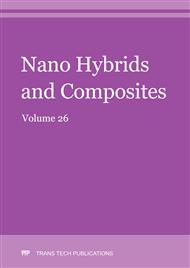[1]
A. A. Firoozi, M. R. Taha, T. A. Khan, F. Hejazi, A. A. Firoozi, J. J. N. H. Alsharef, and Composites, A Novel Method for Mixing Nanomaterials with Soil,, vol. 25, 2019. https://doi.org/10.4028/www.scientific.net/NHC.25.46.
DOI: 10.4028/www.scientific.net/nhc.25.46
Google Scholar
[2]
M. R. Taha, and J. M. Alsharef, Performance of soil stabilized with carbon nanomaterials,, Chemical Engineering Transactions, pp.757-762: Italian Association of Chemical Engineering-AIDIC, 2018. https://doi.org/10.3303/CET1863127.
Google Scholar
[3]
M. R. Taha, and J. M. A. Alsharef, Effect of Dispersion of Nanomaterial on Adhesion Properties of Soil using Atomic Force Microscopy,, International Journal of Advances in Mechanical and Civil Engineering, vol. 5, no. 2, pp.8-12, 2018/6/12, (2018).
Google Scholar
[4]
Mohd R. Taha, Jamal M. A. Alsharef, Tanveer A. Khan, Mubashir Aziz, and M. Gaber., Compressive and tensile strength enhancement of soft soils using nanocarbons,, Geomechanics and Engineering, vol. 16, no. 5, pp.559-567. https://doi.org/10.12989/gae.2018.16.5.559.
Google Scholar
[5]
A. Jorio, G. Dresselhaus, and M. S. Dresselhaus, Carbon nanotubes: advanced topics in the synthesis, structure, properties and applications: Springer Science & Business Media, 2007. https://doi.org/10.1007/978-3-540-72865-8.
DOI: 10.1007/978-3-540-72865-8
Google Scholar
[6]
Z. Wang, L. Ci, L. Chen, S. Nayak, P. M. Ajayan, and N. Koratkar, Polarity-dependent electrochemically controlled transport of water through carbon nanotube membranes,, Nano letters, vol. 7, no. 3, pp.697-702, 2007. https://doi.org/10.1021/nl062853g.
DOI: 10.1021/nl062853g
Google Scholar
[7]
J. Alsharef, M. R. Taha, A. A. Firoozi, and P. Govindasamy, Potential of Using Nanocarbons to Stabilize Weak Soils,, Applied and Environmental Soil Science, vol. 2016, 2016. http://dx.doi.org/10.1155/2016/5060531.
DOI: 10.1155/2016/5060531
Google Scholar
[8]
J. M. Alsharef, M. R. Taha, and T. A. Khan, Physical dispersion of nanocarbons in composites–A review,, Jurnal Teknologi, vol. 79, no. 5, pp.69-81, 2017. https://doi.org/10.11113/jt.v79.7646.
DOI: 10.11113/jt.v79.7646
Google Scholar
[9]
A. Sobolkina, V. Mechtcherine, V. Khavrus, D. Maier, M. Mende, M. Ritschel, and A. Leonhardt, Dispersion of carbon nanotubes and its influence on the mechanical properties of the cement matrix,, Cement and Concrete Composites, vol. 34, no. 10, pp.1104-1113, 2012. https://doi.org/10.1016/j.cemconcomp.2012.07.008.
DOI: 10.1016/j.cemconcomp.2012.07.008
Google Scholar
[10]
K. D. Ausman, R. Piner, O. Lourie, R. S. Ruoff, and M. Korobov, Organic solvent dispersions of single-walled carbon nanotubes: toward solutions of pristine nanotubes,, The Journal of Physical Chemistry B, vol. 104, no. 38, pp.8911-8915, 2000. https://doi.org/10.1021/jp002555m.
DOI: 10.1021/jp002555m
Google Scholar
[11]
Y. Mo, and R. H. Roberts, Carbon Nanofiber Concrete for Damage Detection of Infrastructure,, InTech, 2013. https://doi.org/10.5772/57096.
Google Scholar
[12]
S. Parveen, S. Rana, and R. Fangueiro, A Review on Nanomaterial Dispersion, Microstructure, and Mechanical Properties of Carbon Nanotube and Nanofiber Reinforced Cementitious Composites,, Journal of Nanomaterials, vol. 2013, pp.1-19, 2013. https://doi.org/10.1155/2013/710175.
DOI: 10.1155/2013/710175
Google Scholar
[13]
E. F. de la Cruz, Y. Zheng, E. Torres, W. Li, W. Song, and K. Burugapalli, Zeta potential of modified multi-walled carbon nanotubes in presence of poly (vinyl alcohol) hydrogel,, 2012. http://bura.brunel.ac.uk/handle/2438/10756.
Google Scholar
[14]
L. Cui, Incorporation of Multiwalled Carbon Nanotubes to Ordinary Portland Cement (OPC): Effects on Mechanical Properties,, Advanced Materials Research, vol. 641-642, pp.436-439, 2013. https://doi.org/10.4028/www.scientific.net/AMR.641-642.436.
DOI: 10.4028/www.scientific.net/amr.641-642.436
Google Scholar
[15]
A. Chaipanich, T. Nochaiya, W. Wongkeo, and P. Torkittikul, Compressive strength and microstructure of carbon nanotubes–fly ash cement composites,, Materials Science and Engineering: A, vol. 527, no. 4-5, pp.1063-1067, 2010. https://doi.org/10.1016/j.msea.2009.09.039.
DOI: 10.1016/j.msea.2009.09.039
Google Scholar
[16]
L. Jiang, L. Gao, and J. Sun, Production of aqueous colloidal dispersions of carbon nanotubes,, Journal of Colloid and Interface Science, vol. 260, no. 1, pp.89-94, 2003. https://doi.org/10.1016/S0021-9797(02)00176-5.
DOI: 10.1016/s0021-9797(02)00176-5
Google Scholar
[17]
L. Vaisman, G. Marom, and H. D. Wagner, Dispersions of Surface-Modified Carbon Nanotubes in Water-Soluble and Water-Insoluble Polymers,, Advanced Functional Materials, vol. 16, no. 3, pp.357-363, 2006. https://doi.org/10.1002/adfm.200500142.
DOI: 10.1002/adfm.200500142
Google Scholar
[18]
D. Hanaor, M. Michelazzi, C. Leonelli, and C. C. Sorrell, The effects of carboxylic acids on the aqueous dispersion and electrophoretic deposition of ZrO 2,, Journal of the European Ceramic Society, vol. 32, no. 1, pp.235-244, 2012. https://doi.org/10.1016/j.jeurceramsoc.2011.08.015.
DOI: 10.1016/j.jeurceramsoc.2011.08.015
Google Scholar
[19]
A. Ellis, S. Wallace, and W. Arnold, Surface modification and zeta potentials of carbon nanotube polystyrene nanocomposites., p.110.
Google Scholar
[20]
M. I. Ltd., Zetasizer Nano User Manual,, (2007).
Google Scholar
[21]
J. M. Alsharef, M. R. Taha, R. A. Al-Mansob, and T. A. Khan, Influence of carbon nanofibers on the shear strength and comparing cohesion of direct shear test and AFM,, Journal of Nano Research, vol. 49, pp.108-126, 2017. https://doi.org/10.4028/www.scientific.net/JNanoR.49.108.
DOI: 10.4028/www.scientific.net/jnanor.49.108
Google Scholar
[22]
M. R. Taha, J. M. Alsharef, R. A. AL-mansob, and T. A. Khan, Effects of Nano-Carbon Reinforcement on the Swelling and Shrinkage Behaviour of Soil,, Sains Malaysiana, vol. 47, no. 1, pp.195-205, 2018. http://dx.doi.org/10.17576/jsm-2018-4701-23.
DOI: 10.17576/jsm-2018-4701-23
Google Scholar
[23]
M. R. Taha, and J. M. A. Alsharef, Use of nanocarbons to control swelling, shrinkage, and hydraulic conductivity of a residual soil., Proceedings of the 2nd Symposium on Coupled Phenomena in Environmental Geotechnics (CPEG2), Leeds, UK (2017).
Google Scholar
[24]
A. Alaoui, K. E. Kacemi, K. E. Ass, and S. Kitane, Application of Box-Behnken design to determine the optimal conditions of reductive leaching of MnO2 from manganese mine tailings,, Transactions of the Indian Institute of Metals, vol. 68, no. 5, pp.943-950, 2015. http://dx.doi.org/10.3103/S1067821215020029.
DOI: 10.1007/s12666-015-0528-6
Google Scholar
[25]
M. M. Ba-Abbad, P. V. Chai, M. S. Takriff, A. Benamor, and A. W. Mohammad, Optimization of nickel oxide nanoparticle synthesis through the sol–gel method using Box–Behnken design,, Materials & Design, vol. 86, pp.948-956, 2015. https://doi.org/10.1016/j.matdes.2015.07.176.
DOI: 10.1016/j.matdes.2015.07.176
Google Scholar
[26]
M. N. Chong, H. Zhu, and B. Jin, Response surface optimization of photocatalytic process for degradation of Congo Red using H-titanate nanofiber catalyst,, Chemical Engineering Journal, vol. 156, no. 2, pp.278-285, 2010. https://doi.org/10.1016/j.cej.2009.10.017.
DOI: 10.1016/j.cej.2009.10.017
Google Scholar


